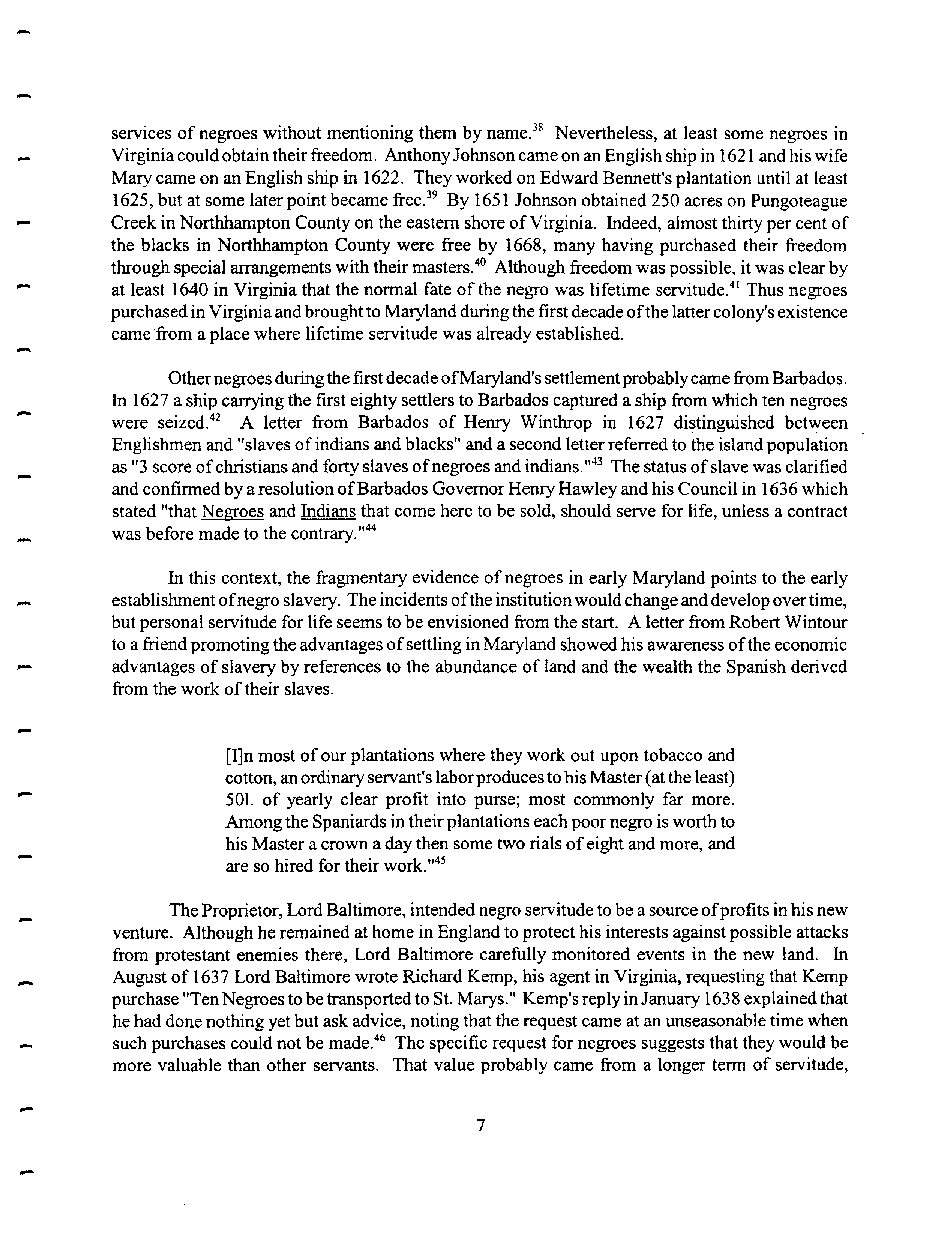|
services of negroes without mentioning them by name.38 Nevertheless, at least some negroes in
Virginia could obtain their freedom. Anthony Johnson came on an English ship in 1621 and his wife
Mary came on an English ship in 1622. They worked on Edward Bennett's plantation until at least
1625, but at some later point became free.39 By 1651 Johnson obtained 250 acres on Pungoteague
Creek in Northhampton County on the eastern shore of Virginia. Indeed, almost thirty per cent of
the blacks in Northhampton County were free by 1668, many having purchased their freedom
through special arrangements with their masters.40 Although freedom was possible, it was clear by
at least 1640 in Virginia that the normal fate of the negro was lifetime servitude.41 Thus negroes
purchased in Virginia and brought to Maryland during the first decade of the latter colony's existence
came from a place where lifetime servitude was already established.
Other negroes during the first decade of Maryland's settlement probably came from Barbados.
In 1627 a ship carrying the first eighty settlers to Barbados captured a ship from which ten negroes
were seized.42 A letter from Barbados of Henry Winthrop in 1627 distinguished between
Englishmen and "slaves of indians and blacks" and a second letter referred to the island population
as "3 score of Christians and forty slaves of negroes and indians."43 The status of slave was clarified
and confirmed by a resolution of Barbados Governor Henry Hawley and his Council in 1636 which
stated "that Negroes and Indians that come here to be sold, should serve for life, unless a contract
was before made to the contrary."44
hi this context, the fragmentary evidence of negroes in early Maryland points to the early
establishment of negro slavery. The incidents of the institution would change and develop over time,
but personal servitude for life seems to be envisioned from the start. A letter from Robert Wintour
to a friend promoting the advantages of settling in Maryland showed his awareness of the economic
advantages of slavery by references to the abundance of land and the wealth the Spanish derived
from the work of their slaves.
[I]n most of our plantations where they work out upon tobacco and
cotton, an ordinary servant's labor produces to his Master (at the least)
501. of yearly clear profit into purse; most commonly far more.
Among the Spaniards in their plantations each poor negro is worth to
his Master a crown a day then some two rials of eight and more, and
are so hired for their work."45
The Proprietor, Lord Baltimore, intended negro servitude to be a source of profits in his new
venture. Although he remained at home in England to protect his interests against possible attacks
from protestant enemies there, Lord Baltimore carefully monitored events in the new land. In
August of 1637 Lord Baltimore wrote Richard Kemp, his agent in Virginia, requesting that Kemp
purchase "Ten Negroes to be transported to St. Marys." Kemp's reply in January 163 8 explained that
he had done nothing yet but ask advice, noting that the request came at an unseasonable time when
such purchases could not be made.46 The specific request for negroes suggests that they would be
more valuable than other servants. That value probably came from a longer term of servitude,
�
|

